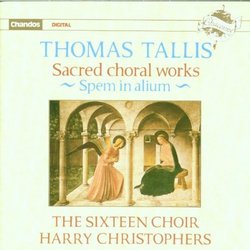A wonderful performance but...
Boileau0663 | Tournai, Belgique | 02/09/2004
(4 out of 5 stars)
"This cd presents the best and most famous sacred works of Reformation England composer Thomas Tallis, including Spem in Alium, a gorgeous piece for 40 voices, and the poignant Lamentations of the prophet Jeremiah. They are sung by a huge mixed choir, which gives the pieces a tremendous power.The rendition is first-rate and deeply moving.
Unfortunately, the clarity of the recording leaves much to be desired. I have played this cd on several hi-fi players and the result has always been disappointing. The sound is muffled, muddy, it does not come out with full force and clarity.
I recommend the "Best of the Renaissance" by the Tallis Scholars if you want to listen to a crystal-clear Spem in Alium and to "Lamenta" performed by Philip Cave et al for the Lamentations of Jeremiah."
Crisp, clean and precise
Leslie Richford | Selsingen, Lower Saxony | 10/25/2008
(5 out of 5 stars)
"Thomas Tallis (1505 - 1585): Sacred Choral Works: Spem in alium - Te lucis ante terminum - O nata lux - from the Lamentations of Jeremiah - O sacrum convivium - Jesu salvator saeculi - Salvator mundi, salva nos - Loquebantur variis linguis - Gaude gloriosa Dei Mater. Performed by The Sixteen, dir. Harry Christophers. Recorded in St. Jude's Church, London, from 15th to 17th October 1989. First issued in 1990 as Chandos Chaconne 0513. Total playing time: 64'50".
Thomas Tallis is perhaps the best-known of the 16th century English renaissance composers. After assuming posts at Dover Priory and Canterbury Cathedral (among others), he was for 40 years until his death "Gentleman" (= kapellmeister) of the Chapel Royal, where he managed to survive the ups and downs of the Reformation and the persecutions of the counter-reformation party. Among his pupils was William Byrd, together with whom he published the Cantiones sacrae (1575). Byrd mourned for Tallis at his death in the song "Ye Sacred Muses".
English church music of the 16th century represents, like so much else from this period, something of a summit in English culture. Medieval polyphony was developed further, and by using five- or six-voiced choirs (with high sopranos or boy trebles) church-filling sounds were produced which, on the one hand, tended to quiet meditation, on the other hand produced unparalleled excitement. Most of the pieces on this CD correspond to this description, although I should add that Harry Christophers nowhere uses boy trebles; instead, he opts for really high female soprano voices. Passages of great density are alternated with passages of homophony, based on Gregorian chant, normally sung by the tenors and basses.
The one exception to the rule is the motet "Spem in Alium", a piece written for eight choirs with forty (!) voices. Tallis appears to have written it as the answer to a similar piece composed by Alessandro Striggio. It must be a magnificent experience to hear this piece sung live, but the recording is, in my opinion, rather distant and able more to demonstrate the limits of a stereo system than really to excite. In order to capture the "cathedral sound" more genuinely, the Chandos engineers have placed the microphones comparatively far away from the singers, and the listener will probably have the feeling of sitting some way back in a large church where the choir or choirs are placed near the altar.
The texts which Tallis has set to music are printed in the booklet in Latin, English, French and German. They reflect the changing times in which Tallis lived. Here we find unashamed Mariology from his youthful period before the Reformation (Gaude gloriosa Dei Mater) right through to texts that any Protestant could say "Amen" to.
At this point I feel I must honour the performance by the Sixteen Choir. Despite the distance between the singers and the microphones, it can be plainly heard (perhaps even more plainly on headphones), how unusually crisp, clean and precise the singing is. This is absolute professionalism! I cannot remember ever hearing a choral performance which bettered this one."


 Track Listings (10) - Disc #1
Track Listings (10) - Disc #1